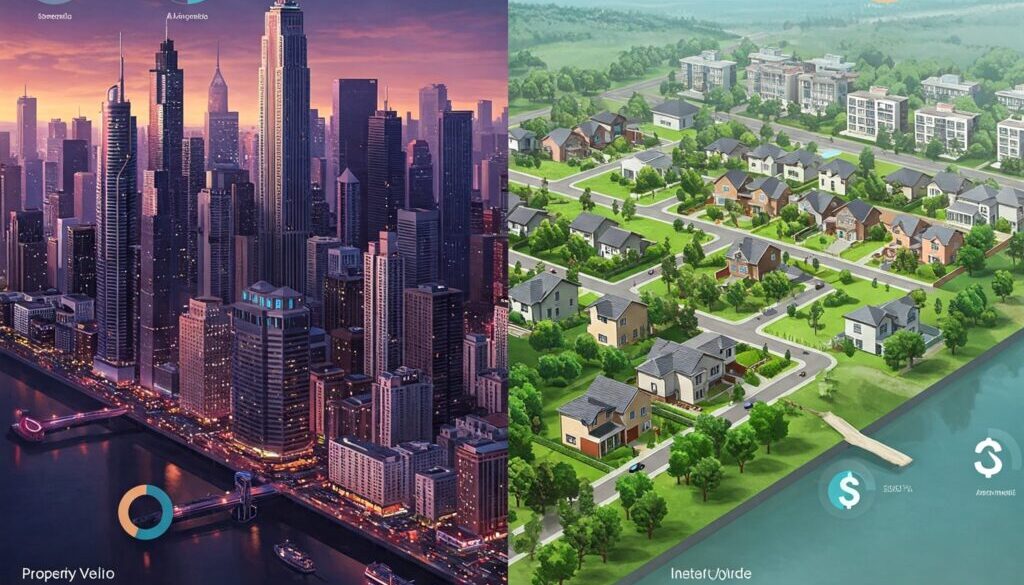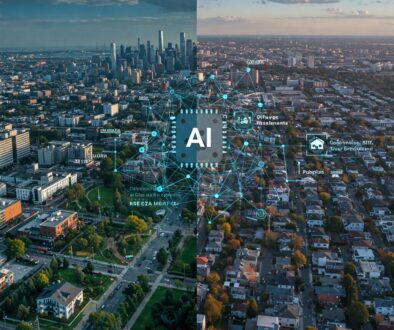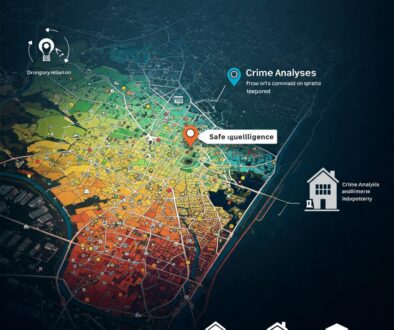Urban vs. Suburban Development: Using AI to Compare Investment Potential
The debate between urban and suburban real estate investment has gained new complexity in the post-pandemic era. Traditional assumptions about each market’s characteristics have been challenged by shifting work patterns, lifestyle preferences, and demographic trends. For investors, choosing between urban and suburban opportunities requires more sophisticated analysis than ever before.
Modern AI-powered geospatial intelligence platforms like Locas.dev are transforming this analysis, moving beyond broad generalizations to provide nuanced, location-specific insights that reveal which urban and suburban areas truly offer the best investment potential in 2025 and beyond.
Evolving Market Dynamics Challenge Traditional Assumptions
The traditional urban-suburban investment dichotomy typically suggested:
Urban Advantages:
- Higher density and rental rates
- Stronger appreciation in core areas
- Better transportation access
- More amenities and cultural attractions
- Stronger appeal to younger demographics
Suburban Advantages:
- Lower entry costs
- Larger living spaces
- Better schools
- Lower crime rates
- Appeal to families and older demographics
However, these generalizations have become increasingly unreliable as:
- Remote work has reduced commute concerns for many professionals
- Urban amenities have expanded into suburban locations
- Transportation options have improved in many suburban areas
- Demographic preferences have evolved across age groups
- Affordability pressures have shifted demand patterns
- Development patterns have created hybrid “urban suburban” environments
“The traditional urban-suburban dichotomy has broken down,” explains Dr. Emma Chen, urban economist at Metropolitan Research Institute. “We’re seeing urban-style developments in suburban locations, suburban characteristics in some urban neighborhoods, and entirely new hybrid forms emerging. Investors need much more granular analysis to identify opportunity in this blended landscape.”
How AI Transforms Urban-Suburban Investment Analysis
Modern geospatial intelligence platforms provide this granular analysis through:
1. Hyperlocal Characteristic Mapping
Rather than broad urban or suburban classifications, AI platforms analyze specific neighborhood characteristics:
- Density gradients measuring precise residential concentration
- Mixed-use metrics quantifying development diversity
- Walkability scoring beyond simple walk scores
- Transit connectivity quality analysis
- Amenity ecosystem mapping by type and quality
- Green space accessibility measurements
- Social environment characteristics assessment
This detailed mapping allows investors to identify areas with optimal characteristic combinations rather than relying on simple urban/suburban labels.
2. Pattern Recognition Across Markets
AI excels at identifying subtle patterns that traditional analysis might miss:
- Success pattern matching across different markets
- Transformation sequence recognition identifying predictable evolution
- Anomaly detection highlighting unusual opportunities
- Correlation analysis between characteristics and performance
- Multi-factor success indicators beyond single metrics
“What’s remarkable is how AI analysis identified specific suburban nodes that were developing ‘urban amenity gravity’ – the ability to attract and sustain urban-style amenities despite suburban locations,” notes Jonathan Ramirez of Meridian Investments. “These hybrid locations showed appreciation and rental growth patterns more similar to successful urban cores than traditional suburbs.”
3. Demographic-Location Alignment
Perhaps most powerfully, AI can identify how changing demographic preferences align with specific locations:
- Lifestyle preference mapping across different demographics
- Life stage migration pattern analysis
- Household formation trend correlation with location types
- Remote work adoption impact on location preferences
- Generational location preference evolution tracking
Key Comparison Factors Between Urban and Suburban Investments
Modern geospatial intelligence platforms evaluate urban and suburban investment opportunities across several critical dimensions:
1. Density and Development Patterns
AI Analysis Approach: Rather than simple density measurements, AI evaluates the nature and quality of density:
- Livable density metrics measuring how well-designed density is
- Mixed-use integration quality assessment
- Pedestrian vs. auto-oriented design scoring
- Density change trajectories predicting future patterns
- Building typology diversity analysis
Insight Example: “Traditional analysis would simply note that Riverside Heights had a moderate density of 18 units per acre,” explains urban planner Lisa Wong. “The AI analysis revealed something more nuanced: the area had achieved ‘effective density’ – enough concentration to support walkable retail and amenities while maintaining open space through clever design. This created surprising amenity strength despite being technically ‘suburban’ by most measures.”
2. Accessibility and Connectivity
AI Analysis Approach: Modern platforms move beyond simple distance measurements to analyze:
- Multi-modal connectivity quality across transportation types
- Destination accessibility scoring to common needs
- Digital connectivity infrastructure assessment
- Last-mile transportation options inventory
- Peak vs. off-peak accessibility variations analysis
Insight Example: When evaluating two seemingly similar suburban office parks, Horizon Investment Group discovered through AI analysis that one location had significantly better “connectivity resilience” – the ability to maintain accessibility through multiple transport modes. This difference led to a 24% lower vacancy rate and 17% higher rent achievement even though traditional metrics showed the properties as nearly identical.
3. Amenity Ecosystem Analysis
AI Analysis Approach: Instead of simple amenity counts, AI evaluates the comprehensive amenity ecosystem:
- Amenity diversity scoring across categories
- Quality-adjusted amenity density measurement
- Amenity sustainability analysis predicting longevity
- Experience-based amenity mapping beyond traditional retail
- Amenity gap identification highlighting opportunities
Insight Example: “Two urban neighborhoods showed similar amenity counts in traditional analysis,” notes retail analyst James Chen. “However, the AI assessment revealed that one area had achieved ‘amenity ecosystem completion’ with a self-reinforcing mix of complementary businesses, while the other had fragmented amenities that didn’t create synergy. The difference in residential rent achievement was 31% despite similar locations and demographics.”
4. Economic Trajectory Mapping
AI Analysis Approach: Advanced platforms analyze economic patterns that drive long-term investment performance:
- Job creation density and quality assessment
- Income growth pattern analysis by area
- Business formation and mortality rates tracking
- Industry diversity and resilience scoring
- Economic innovation indicators identification
Insight Example: A suburban office corridor in Denver showed modest performance by traditional metrics, but AI analysis identified a powerful “innovation clustering effect” happening as specific technology companies began attracting related businesses. Investors who recognized this pattern achieved 47% higher returns compared to similar suburban office investments that lacked this emergent clustering pattern.
5. Development Potential Analysis
AI Analysis Approach: Understanding how locations can evolve is critical to predicting long-term performance:
- Underutilized density identification highlighting opportunity
- Regulatory evolution prediction forecasting policy changes
- Infrastructure capacity assessment identifying limitations
- Redevelopment probability scoring across properties
- Adaptive reuse potential evaluation
Insight Example: Comparing an urban and suburban retail investment opportunity, Capital Partners found that while the urban location had higher current returns, the suburban property had significantly greater “development elasticity” – the ability to evolve in response to market changes. This flexibility ultimately created 36% higher returns over a 10-year hold period despite lower initial performance.
Case Study: The Crossroads District Comparison
When Evergreen Investments was deciding between two opportunities – one in an urban neighborhood and one in a suburban town center – traditional analysis provided unclear guidance. Both showed similar pricing, recent performance, and projected returns based on conventional metrics.
Using Locas.dev’s comparative analysis, a more nuanced picture emerged:
The Urban Opportunity: Westside District
Traditional Analysis:
- Established urban neighborhood
- Strong recent rent growth
- Good transit accessibility
- Diverse amenity mix
- Higher density
AI-Enhanced Insights:
- Amenity saturation at 92% with limited growth potential
- Rent growth driving actual affordability pressure
- Early indicators of “experience flight” as residents sought better value
- Infrastructure at 97% of capacity with significant upgrade costs looming
- Limited development potential due to regulatory constraints
The Suburban Opportunity: Northpoint Center
Traditional Analysis:
- Emerging suburban town center
- Moderate recent performance
- Car-dependent with some transit
- Growing amenity base
- Lower density
AI-Enhanced Insights:
- Amenity ecosystem at 68% of potential with strong completion trajectory
- Transportation infrastructure evolution showing rapid improvement
- “Urban advantage adoption” pattern indicating urban-style benefits emerging
- Regulatory environment shifting to support higher density
- Strong demographic alignment with highest-growth population segments
Based on this comprehensive comparison, Evergreen invested in the suburban opportunity despite its less impressive traditional metrics. Within 24 months, the suburban investment outperformed the urban alternative by 28% in value growth as the AI-identified positive factors accelerated.
Investment Strategy Implications: Moving Beyond Urban vs. Suburban
Based on advanced geospatial intelligence, the most sophisticated investors are now:
1. Focusing on Characteristics Over Classifications
Rather than categorizing investments as simply urban or suburban, identify the specific characteristics that drive performance regardless of classification:
- Prioritize amenity ecosystem quality and completeness
- Evaluate true connectivity rather than simple location type
- Assess regulatory trajectory and development potential
- Analyze demographic alignment with location characteristics
- Measure resilience and adaptability to changing conditions
2. Identifying Hybrid Success Patterns
The highest-performing investments often combine traditionally urban and suburban characteristics in unique ways:
- Suburban locations with urban-style amenity concentrations
- Urban areas with suburban-quality schools and safety
- Transit-oriented developments in traditionally car-dependent areas
- Neighborhood-scale developments with regional connectivity
- Mixed-use environments with strong nature access
3. Matching Investment Types to Location Trajectories
Different investments perform best in different types of location evolution:
- Early-stage urban regeneration areas – Higher risk but potentially higher returns for value-add strategies
- Mature urban cores – Better suited for stabilized cash flow investments
- Emerging suburban nodes – Opportunity for strategic development plays
- Transitional hybrid districts – Ideal for adaptive repositioning strategies
- Stable suburban locations – Strong for specific demographic-targeted investments
4. Creating Portfolio Diversity Through Location Intelligence
Sophisticated location analysis allows for strategic diversification:
- Balance investments across different development stages
- Diversify across location types with uncorrelated risk profiles
- Include properties with complementary demographic targets
- Spread exposure across areas with different economic drivers
- Combine locations with varied regulatory risk profiles
The Future of Urban-Suburban Investment Analysis
As geospatial intelligence continues to evolve, several emerging capabilities promise even more sophisticated urban-suburban investment analysis:
- Real-time sentiment tracking measuring how people actually experience different locations
- Mobility pattern analysis showing how people interact with locations throughout their day
- Experience quality quantification beyond simple amenity counts
- Virtual testing of potential development scenarios
- Cross-market comparative learning applying insights from different geographies
Conclusion: Beyond Binary Thinking in Location Strategy
The most successful real estate investors in 2025 and beyond will be those who move past simplistic urban versus suburban categorizations to a more sophisticated understanding of location characteristics, patterns, and trajectories.
By leveraging AI-powered geospatial intelligence, investors can:
- Identify specific success factors that transcend traditional urban/suburban labels
- Recognize emerging patterns before they’re obvious in market metrics
- Match investment strategies to location-specific opportunities
- Build diversified portfolios based on nuanced location understanding
- Adapt to changing preferences with early-warning indicators
In a real estate landscape where traditional boundaries continue to blur, the competitive edge belongs to those with the most comprehensive location intelligence.
Ready to move beyond simplistic urban-suburban comparisons in your investment strategy? Try Locas.dev today and discover the power of AI-driven location comparison.
This article reflects the current understanding of urban and suburban investment comparison. For the latest updates and features, visit Locas.dev.
Keywords: urban vs suburban investment, real estate location comparison, geospatial analysis real estate, urban property investment, suburban development analysis, location intelligence real estate, AI property comparison



